Gymnocarpium dryopteris (Common Oak Fern)
| Also known as: | Northern Oak Fern |
|---|---|
| Genus: | Gymnocarpium |
| Family: | Dryopteridaceae (Wood Fern) |
| Life cycle: | perennial |
| Origin: | native |
| Habitat: | part shade, shade; cool, moist soil; coniferous and mixed forest, talus slopes |
| Fruiting season: | summer |
| Plant height: | 4 to 15 inches |
| Wetland Indicator Status: | GP: FACU MW: FAC NCNE: FACU |
| MN county distribution (click map to enlarge): |  |
| National distribution (click map to enlarge): |  |
Pick an image for a larger view. See the glossary for icon descriptions.
Detailed Information
Fiddlehead:
![[photo of fiddleheads]](/udata/r9ndp23q/ferns/gymnocarpium-dryopteris-common-oak-fern_0603_154039-t.jpg) Fiddleheads emerge in early spring on slender, hairless, green to purple-brown stems. As the leaves unfurl, the division of the stem into 3 parts becomes apparent.
Fiddleheads emerge in early spring on slender, hairless, green to purple-brown stems. As the leaves unfurl, the division of the stem into 3 parts becomes apparent.
Leaves and stems: 

![[photo of frond]](/udata/r9ndp23q/ferns/gymnocarpium-dryopteris-common-oak-fern_0512_101537-t.jpg) At the top of the stem is a single compound leaf (frond) though appears like a whorl of 3 leaves. The leaf is generally triangular in outline, up to 7 inches long and about as wide, with 6 to 10 pair of branches (pinnae) oppositely arranged. The lowest pair of branches are typically twice compound, triangular in outline, to 4½ inches long, somewhat smaller to about as large as the rest of the leaf, stalked and connected to the main stem at a swollen node. Upper branches are once compound or merely lobed, stalkless, more oblong in outline but tapering to a pointed tip and generally curve upward. The leaves are held horizontally, nearly parallel to the ground, and typically bright yellow-green.
At the top of the stem is a single compound leaf (frond) though appears like a whorl of 3 leaves. The leaf is generally triangular in outline, up to 7 inches long and about as wide, with 6 to 10 pair of branches (pinnae) oppositely arranged. The lowest pair of branches are typically twice compound, triangular in outline, to 4½ inches long, somewhat smaller to about as large as the rest of the leaf, stalked and connected to the main stem at a swollen node. Upper branches are once compound or merely lobed, stalkless, more oblong in outline but tapering to a pointed tip and generally curve upward. The leaves are held horizontally, nearly parallel to the ground, and typically bright yellow-green.
![[close-up of pinnae]](/udata/r9ndp23q/pd3/gymnocarpium-dryopteris-13-10-t.jpg) Each branch is divided into smaller segments (pinnules) that are oblong in outline, rounded at the tip, divided into several rounded lobes or merely scalloped around the edges. Veins are freely branched or sometimes merely forked. Both surfaces and all branch stalks are hairless and lack glands.
Each branch is divided into smaller segments (pinnules) that are oblong in outline, rounded at the tip, divided into several rounded lobes or merely scalloped around the edges. Veins are freely branched or sometimes merely forked. Both surfaces and all branch stalks are hairless and lack glands.
![[photo of lower stipe]](/udata/r9ndp23q/ferns/gymnocarpium-dryopteris-common-oak-fern_0512_101610-t.jpg) The main stem (stipe) is slender, up to about 12 inches long, dark purplish-brown near the base, brownish to straw-colored above, smooth except for scattered tan scales.
The main stem (stipe) is slender, up to about 12 inches long, dark purplish-brown near the base, brownish to straw-colored above, smooth except for scattered tan scales.
Spores: 
![[photo of mature sori]](/udata/r9ndp23q/ferns/gymnocarpium-dryopteris-common-oak-fern_0716_181900-t.jpg) The sori (group of spores) are found on the underside of the leaf. They are circular and arranged around the edges of a pinnule, at the tip of a vein, and often merge at maturity. There is no extra tissue (indusium) that surrounds or covers the spores. Spores ripen to dark brown, though not all leaves have spores.
The sori (group of spores) are found on the underside of the leaf. They are circular and arranged around the edges of a pinnule, at the tip of a vein, and often merge at maturity. There is no extra tissue (indusium) that surrounds or covers the spores. Spores ripen to dark brown, though not all leaves have spores.
Notes:
Common Oak Fern is a common fern in forested regions across Minnesota. It is reported to originally be a fertile hybrid between two other Gymnocarpium species (G. appalachianum endemic to Appalachia in the east, and G. disjunctum in the Pacific northwest), which somehow got together and created this child that spread throughout Canada, into Greenland and Alaska, across the northern US, and into the mountains of the west. Crazy-wonderful, eh?
There are 3 Oak fern species in Minnesota, all relatively small, under 16 inches tall, and have what appears to be 3 leaves whorled at the top of the stem which are held more or less horizontally, parallel to the ground. G. dryopteris is the most common and the only one that has completely hairless stems and leaves, lacking any glands, where the other two have glandular hairy stems and leaves, G.continentale (formerly G. jessoense) with glands on leaf undersides and G. robertianum with glands on both leaf surfaces. G. dryopteris is apparently rather promiscuous and has been known to hybridize with both of these species, as well as with both of its parents. These hybrids usually have sterile, blackish, malformed spores but sometimes also round, brown spores that may be fertile.
Native Plant Nurseries, Restoration and Landscaping Services ↓
More photos
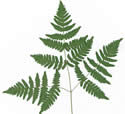 scan of plant
scan of plant Common Oak Fern plants
Common Oak Fern plants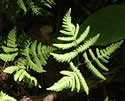 Common Oak Fern plants
Common Oak Fern plants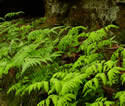 Common Oak Fern plants
Common Oak Fern plants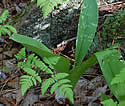 Common Oak Fern with Bluebead Lily
Common Oak Fern with Bluebead Lily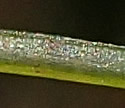 stems and leaves are hairless, lacking any glands
stems and leaves are hairless, lacking any glands
Photos by K. Chayka taken in Aitkin, Carlton, Itasca, Pine and St. Louis counties. Photos by Peter M. Dziuk taken in Aitkin, Cook, Itasca and Pine
Comments
Have you seen this plant in Minnesota, or have any other comments about it?
on: 2020-06-09 14:38:16
Common in woodland with rose twisted stalk, meadow rue, baneberry and other understory plants
on: 2022-07-30 18:54:55
Numerous large patches in a sugar maple forest.






